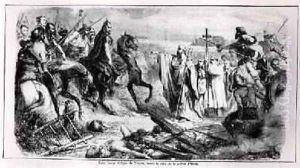Adolphe Francois Pannemaker Paintings
Adolphe François Pannemaker was a prominent Belgian wood engraver whose work gained significant recognition in the 19th century. Born in 1822 in Brussels, Belgium, Pannemaker hailed from a family with artistic inclinations, which greatly influenced his early exposure to the arts. He was particularly known for his mastery in wood engraving, a technique that involves carving an image into the cross-section of a wood block, which is then inked and pressed onto paper to create a print. This method was a primary form of reproducing images before the advent of photographic processes.
Pannemaker's career flourished in a time when the demand for illustrated books and periodicals was burgeoning, largely driven by advancements in printing technology and an expanding literate public. He worked extensively for publishers in Belgium and France, contributing engravings to various books, magazines, and newspapers. His engravings were often based on the works of contemporary artists and illustrators, translating their paintings and drawings into prints that could be reproduced and distributed widely. Pannemaker's skill in capturing detail and his ability to convey the depth and texture of the original artworks made his engravings highly sought after.
Throughout his career, Adolphe François Pannemaker received numerous accolades for his contributions to the field of engraving. His works were exhibited in many prestigious galleries and were acclaimed for their precision and artistic quality. Despite the technological shifts in the printing industry, Pannemaker's engravings remained popular for their aesthetic value and craftsmanship. He was not only a master of his craft but also played a significant role in the development of graphic arts during his time. Pannemaker passed away in 1900, leaving behind a legacy that continues to be celebrated by art historians and collectors alike. His engravings serve as a testament to the skill and dedication of wood engravers in the 19th century, capturing the intricacies of the visual world in the grooves of wooden blocks.
